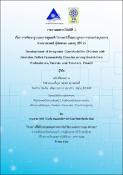บทคัดย่อ
การบูรณาการการดูแลระหว่างผู้ปกครองครูและผู้ให้บริการด้านการดูแลสุขภาพเป็นสิ่งสำคัญสำหรับการรักษาเด็กที่มีภาวะซนสมาธิสั้นให้ประสบความสำเร็จ อย่างไรก็ตาม ผู้ปกครอง ครูและผู้ให้บริการทางการแพทย์มีแลกเปลี่ยนข้อมูลที่เกี่ยวข้องกับการดูแลเด็กโรคสมาธิสั้นน้อยและขาดเครื่องมือที่เป็นนวัตกรรมเพื่อสนับสนุนการดูแลแบบบูรณาการดังกล่าว การใช้เครื่องมือบนมือถือ (Mobile Health, mHealth) อาจช่วยเชื่อมโยงการดูแลระหว่างผู้ปกครอง ครูและผู้ให้บริการทางการแพทย์ ช่วยให้มีการสื่อสารข้อมูลที่จำเป็น รวมทั้งเป็นแหล่งข้อมูลความรู้ที่เชื่อถือได้ในการดูแลเด็กโรคสมาธิสั้นADHD ต่อผลด้านการควบคุมอาการของโรคสมาธิสั้นและลดความเครียดของผู้ปกครองและครู วิธีการวิจัย: กลุ่มตัวอย่างที่ศึกษาประกอบด้วยเด็กที่ได้รับการวินิจฉัยด้วยโรคสมาธิสั้น จำนวน 41 คนและผู้ปกครอง 41 คน จากสถาบันพัฒนาการเด็กระดับตติยภูมิ, ครู 41 คน และผู้ให้บริการด้านสุขภาพ 5 คน กลุ่มตัวอย่างได้รับการสุ่มไปยังสามกลุ่มต่อไปนี้: (1) กลุ่มศึกษาที่ผู้ปกครองและครูได้รับการฝึกอบรมให้ใช้ ADHD Care Model (IACM) ร่วมกับ Application ADHD บนมือถือ (AA); (2) กลุ่มควบคุมที่ผู้ปกครองและครูได้รับการฝึกอบรมให้ใช้ IACM หรือ (3) กลุ่มควบคุมที่ผู้เข้าร่วมได้รับการดูแลแบบปกติ (UC) วัดผลการวิจัยด้วยอาการของโรคสมาธิสั้น ประเมินโดยผู้ปกครองและครูด้วยแบบประเมิน SNAP-IV และความเครียดของผู้ปกครองและครูโดยใช้เครื่องมือวัดระดับความเครียด SPST-20 โดยการบันทึกข้อมูล ณ จุดเริ่มต้นการวิจัยเดือนที่ 1, 2 และ 3 ผลการวิจัย: เด็กในกลุ่มที่ใช้การดูแลแบบ IACM + AA มีคะแนน SNAP-IV ณ เดือนที่ 3 ต่ำกว่ากลุ่มที่ได้รับการดูแลตามปกติ (p<.05) นอกจากนี้พบว่าคะแนนความเครียดของผู้ปกครองและครูในกลุ่ม IACM + AA และกลุ่ม IACM ต่ำกว่ากลุ่ม UC อย่างมีนัยสำคัญ ณ เดือนที่ 3 (p<.05) แต่ไม่พบความแตกต่างระหว่างกลุ่ม IACM + AA และกลุ่ม IACM สรุป: การศึกษานี้สนับสนุนความเป็นไปได้ของการใช้ Application ADHD ร่วมกับแนวทางการดูแลเด็กโรคสมาธิสั้นแบบบูรณาการระหว่าง ผู้ปกครอง ครู และบุคลากรทางการแพทย์ ในการดูแลเด็กโรคสมาธิสั้น เพื่อผลลัพธ์ด้านการลดอาการของโรคสมาธิสั้นและลดความเครียดของผู้ปกครองและครู
บทคัดย่อ
Background: Integration of care among parents, teachers, and healthcare providers is crucial
for successful treatment of children with ADHD. However, parents, teachers, and healthcare
providers share limited data on caring ADHD children and lack of innovative tools to support
the integration of care among. A mobile health (mHealth) approach may bridge the gap
among parents, teachers, and healthcare providers, allowing communications with necessary
information as well as ADHD source of reliable informationto improve ADHD symptoms and
reduce stress of parents and teachers.
Method: The study sample included 41 children with ADHD and 41 parents from a tertiary
care child development hospital, 41 teachers, and 5 healthcare providers of the children.
Participants were randomly assigned to one of the following three groups: (1) a study group
in which the parents, teachers were trained to use the Integrated ADHD Care Model (IACM)
with the Application ADHD on mobile (AA); (2) a control group in which the parents and
teachers were trained to use IACM; or to (3) a control group in which participants were
treated with usual care (UC). ADHD symptoms assessed by parents and teachers using the
SNAP-IV rating scale and stress of parents and teachers were rated usingthe SPST-20 were
recorded at baseline, month 1, 2, and 3.
Results: Participants who used IACM+AA demonstrated lower ADHD symptom score over 3-
month period compared with usual care (p<.05). In addition, a significant improvement in
stress scores in parents and teachers were found among the IACM+AA group and IACM group
compared to UC group in 3 months (p<.05). No significant difference of stress scores was
found between IACM+AA and IACM groups.
Conclusions: The current study provides support for the feasibility of a new mobile app in
supporting care for children with ADHDto improve ADHD symptoms and reduce stress of
parents and teachers.


